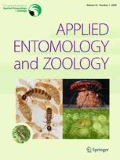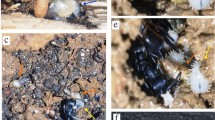Abstract
The parasitoid Lysiphlebus japonicus Ashmead is able to exploit aphids attended by ants and is therefore a candidate for a biological control agent of ant-attended aphids, but there is little information on the factors that influence changes in the population of this parasitoid. The species of aphid-attending ants may be a factor in seasonal fluctuations in its occurrence. This study experimentally examined how each of the two ant species Lasius japonicus Santschi and Pristomyrmex punctatus Smith influences the seasonal change in the abundance of this ant-adapted parasitoid in the colonies of the spirea aphid Aphis spiraecola Patch, which the ant species attends, on citrus in Japan. The numbers of aphid mummies formed by the parasitoid and ovipositing parasitoid females in the ant-attended aphid colonies in late spring (mid- to late May) were compared with the numbers in mid-summer (late July to mid-August) for each ant species. Significantly more mummies were found in the aphid colonies attended by P. punctatus than in the colonies attended by Lasius japonicus in both seasons. The number of mummies in P. punctatus-attended aphid colonies did not differ significantly between the two seasons. In the Lasius japonicus-attended colonies, however, the mummy numbers were significantly reduced in mid-summer compared with late spring. The seasonal distribution of mummy numbers was significantly dependent on the aphid-attending ant species. The number of parasitoid females that deposited eggs in the ant-attended aphid colonies varied in a similar manner to the number of mummies. Thus, the species of aphid-attending ant determines the seasonal difference in the abundance of the ant-adapted parasitoid in ant-attended aphid colonies. Possible underlying mechanisms for this result and its implications for the biological control of ant-attended aphids on citrus are discussed.


Similar content being viewed by others
References
Addicott JF (1979) A multispecies aphid–ant association: density dependence and species-specific effects. Can J Zool 57:558–569
Andersen AN (1986) Diversity, seasonality and community organization of ants at adjacent heath and woodland sites in southeastern Australia. Aust J Zool 34:53–64
Banks CJ (1962) Effects of the ant Lasius niger (L.) on insects preying on small populations of Aphis fabae Scop. on bean plants. Ann Appl Biol 50:669–679
Bartlett BR (1961) The influence of ants upon parasites, predators, and scale insects. Ann Entomol Soc Am 54:543–551
Barzman MS, Daane KM (2001) Host-handling behaviours in parasitoids of the black scale: a case for ant-mediated evolution. J Anim Ecol 70:237–247
Basu P (1997) Seasonal and spatial patterns in ground foraging ants in a rain forest in the Western Ghats India. Biotropica 29:489–500
Bristow CM (1984) Differential benefits from ant attendance to two species of Homoptera on New York ironweed. J Anim Ecol 53:715–726
Buckley RC (1987) Interactions involving plants, Homoptera, and ants. Annu Rev Ecol Syst 18:111–135
Buckley RC, Gullan P (1991) More aggressive ant species (Hymenoptera: Formicidae) provide better protection for soft scales and mealybugs (Homoptera: Coccidae, Pseudococcidae). Biotropica 23:282–286
Calabuig A, Tena A, Wäckers FL, Fernández-Arrojo L, Plou FJ, Garcia-Marí F, Pekas A (2015) Ants impact the energy reserves of natural enemies through the shared honeydew exploitation. Ecol Entomol 40:687–695
Cudjoe AR, Neuenschwander P, Copland MJW (1993) Interference by ants in biological control of the cassava mealybug Phenacoccus manihoti (Hemiptera: Pseudococcidae) in Ghana. Bull Entomol Res 83:15–22
Cushman JH, Whitham TG (1989) Conditional mutualism in a membracid–ant association: temporal, age-specific, and density-dependent effects. Ecology 70:1040–1047
Del-Claro K, Oliveira PS (2000) Conditional outcomes in a neotropical treehopper–ant association: temporal and species-specific variation in ant protection and homopteran fecundity. Oecologia 124:156–165
Dempster JP, McLean IFG (1998) Insect populations in theory and in practice. Kluwer, Dordrecht
Eisner T, Hicks K, Eisner M, Robson DS (1978) “Wolf-in-sheep’s-clothing” strategy of a predaceous insect larva. Science 199:790–794
El Keroumi A, Naamani K, Soummane H, Dahbi A (2012) Seasonal dynamics of ant community structure in the Moroccan Argan Forest. J Insect Sci 12:94
Frazer BD, van den Bosch R (1973) Biological control of the walnut aphid in California: the inter-relationship of the aphid and its parasite. Environ Entomol 2:561–568
Haines IH, Haines JB (1978) Colony structure, seasonality and food requirements of the crazy ant, Anoplolepis longipes (Jerd.), in the Seychelles. Ecol Entomol 3:109–118
Hölldobler B, Wilson EO (1990) The ants. Harvard University Press, Cambridge
Itioka T, Inoue T (1996) The consequences of ant-attendance to the biological control of the red wax scale insect Ceroplastes rubens by Anicetus beneficus. J Appl Ecol 33:609–618
Itioka T, Inoue T (1999) The alternation of mutualistic ant species affects the population growth of their trophobiont mealybug. Ecography 22:169–177
Kaneko S (2002) Aphid-attending ants increase the number of emerging adults of the aphid’s primary parasitoid and hyperparasitoids by repelling intraguild predators. Entomol Sci 5:131–146
Kaneko S (2003a) Different impacts of two species of aphid-attending ants with different aggressiveness on the number of emerging adults of the aphid’s primary parasitoid and hyperparasitoids. Ecol Res 18:199–212
Kaneko S (2003b) Impacts of two ants, Lasius niger and Pristomyrmex pungens (Hymenoptera: Formicidae), attending the brown citrus aphid, Toxoptera citricidus (Homoptera: Aphididae), on the parasitism of the aphid by the primary parasitoid, Lysiphlebus japonicus (Hymenoptera: Aphidiidae), and its larval survival. Appl Entomol Zool 38:347–357
Kaneko S (2007) Predator and parasitoid attacking ant-attended aphids: effects of predator presence and attending ant species on emerging parasitoid numbers. Ecol Res 22:451–458
Korenaga R, Koizumi M, Ushiyama K, Furuhashi K (1992) A handbook of diseases and insect pests of fruit trees, vol 1. Citrus, loquat and kiwifruit. Japan Plant Protection Association, Tokyo (in Japanese)
Liere H, Perfecto I (2008) Cheating on a mutualism: indirect benefits of ant attendance to a coccidophagous coccinellid. Environ Entomol 37:143–149
Moritsu M (1983) Aphids of Japan in colors. Zenkoku Noson Kyoiku Kyokai, Tokyo (in Japanese)
Nixon GEJ (1951) The association of ants with aphids and coccids. Commonwealth Institute of Entomology, London
Oliver TH, Leather SR, Cook JM (2012) Ant larval demand reduces aphid colony growth rates in an ant–aphid interaction. Insects 3:120–130
Pekas A, Tena A, Aguilar A, Garcia-Marí F (2011) Spatio-temporal patterns and interactions with honeydew-producing Hemiptera of ants in a Mediterranean citrus orchard. Agric For Entomol 13:89–97
Pontin AJ (1959) Some records of predators and parasites adapted to attack aphids attended by ants. Entomol Mon Mag 95:154–155
Price PW, Denno RF, Eubanks MD, Finke DL, Kaplan I (2011) Insect ecology: behavior, populations and communities. Cambridge University Press, New York
R Development Core Team (2017) R: a language and environment for statistical computing. R Foundation for Statistical Computing, Vienna. http://www.R-project.org. Accessed 14 Oct 2017
Retana J, Cerdá X (2000) Patterns of diversity and composition of Mediterranean ground ant communities tracking spatial and temporal variability in the thermal environment. Oecologia 123:436–444
Sakata H, Katayama N (2001) Ant defence system: a mechanism organizing individual responses into efficient collective behavior. Ecol Res 16:395–403
Stechmann DH, Völkl W, Starý P (1996) Ant-attendance as a critical factor in the biological control of the banana aphid Pentalonia nigronervosa Coq. (Hom. Aphididae) in Oceania. J Appl Entomol 120:119–123
Takada H (1968) Aphidiidae of Japan (Hymenoptera). Insecta Matsumurana 30:67–124
Takada H, Hashimoto Y (1985) Association of the root aphid parasitoids Aclitus sappaphis and Paralipsis eikoae (Hymenoptera: Aphidiidae) with the aphid-attending ants Pheidole fervida and Lasius niger (Hymenoptera: Formicidae). Kontyû 53:150–160
Takanashi M (1990) Development and reproductive ability of Lysiphlebus japonicus Ashmead (Hymenoptera: Aphidiidae) parasitizing the citrus brown aphid, Toxoptera citricidus (Kirkaldy) (Homoptera: Aphididae). Jpn J Appl Entomol Zool 34:237–243 (in Japanese with English summary)
Vinson SB, Scarborough TA (1991) Interactions between Solenopsis invicta (Hymenoptera: Formicidae), Rhopalosiphum maidis (Homoptera: Aphididae), and the parasitoid Lysiphlebus testaceipes Cresson (Hymenoptera: Aphidiidae). Ann Entomol Soc Am 84:158–164
Völkl W (1992) Aphids or their parasitoids: who actually benefits from ant-attendance? J Anim Ecol 61:273–281
Völkl W (1995) Behavioral and morphological adaptations of the coccinellid Platynaspis luteorubra for exploiting ant-attended resources (Coleoptera: Coccinellidae). J Insect Behav 8:653–670
Völkl W, Mackauer M (1993) Interactions between ants attending Aphis fabae ssp. cirsiiacanthoidis on thistles and foraging parasitoid wasps. J Insect Behav 6:301–312
Völkl W, Stechmann DH (1998) Parasitism of the black bean aphid (Aphis fabae) by the Lysiphlebus fabarum (Hym., Aphidiidae): the influence of host plant and habitat. J Appl Entomol 122:201–206
Way MJ (1963) Mutualism between ants and honeydew-producing Homoptera. Annu Rev Entomol 8:307–344
Wolda H (1988) Insect seasonality: why? Annu Rev Ecol Syst 19:1–18
Yao I (2014) Costs and constraints in aphid-ant mutualism. Ecol Res 29:383–391
Zhou A, Kuang B, Gao Y, Liang G (2015) Density-dependent benefits in ant-hemipteran mutualism? The case of the ghost ant Tapinoma melanocephalum (Hymenoptera: Formicidae) and the invasive mealybug Phenacoccus solenopsis (Hemiptera: Pseudococcidae). PLoS One 10(4):e0123885
Author information
Authors and Affiliations
Corresponding author
Rights and permissions
About this article
Cite this article
Kaneko, S. Seasonal differences in the abundance of an ant-adapted parasitoid, Lysiphlebus japonicus (Hymenoptera: Aphidiidae), in ant-attended colonies of the spirea aphid Aphis spiraecola (Hemiptera: Aphididae) on citrus: comparison for two ant species, Lasius japonicus and Pristomyrmex punctatus (Hymenoptera: Formicidae). Appl Entomol Zool 53, 315–321 (2018). https://doi.org/10.1007/s13355-018-0560-1
Received:
Accepted:
Published:
Issue Date:
DOI: https://doi.org/10.1007/s13355-018-0560-1




